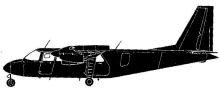Incident Overview

Description
The crew elected to conduct a practice autoland approach during a scheduled airline flight in order to recertify the airplane for category 3 (CAT III) autoland procedures. Airline procedures permit crews to conduct such approaches when weather is at category 1 (CAT I) minimums or better. Weather at the time of the accident included good visual conditions, and was not a factor in the accident. Additionally, wake turbulence was not a factor in the accident. The airline’s flight operations manual stated: “Except for facilities that have a restrictive note, autoland approaches are permissible to all [instrument landing system (ILS)] facilities. When a restrictive note regarding the localizer or glide slope appears on [an approach chart], autoland is not authorized.” The ILS runway 8 approach chart was notated “unusable from 0.8 nm to threshold.” The crew reported, and the flight data recorder (FDR) confirmed, that the airplane began to drift off the centerline of the approach at about three-quarters of a mile from the runway threshold. The drift was consistent with the direction of the wind and the ILS chart notation. Additionally, both Federal Aviation Administration (FAA) advisory material, and the airline’s flight operations manual direct pilots to advise air traffic control (ATC) when conducting an autoland approach, to allow ATC to ensure that appropriate areas are clear of vehicles or other obstructions which may affect the localizer signals. The flight crew did not advise ATC of the autoland approach. After the airplane drifted off the centerline, the first officer disconnected the autopilot and hand-flew the airplane back to the center of the runway, thereby prolonging the flare. Airline training material noted that a prolonged flare is a risk factor for tailstrikes. The airplane did not touch down until approximately 4,000 feet from the landing threshold. Recovering from the drift off-centerline led to the first officer prolonging the flare, and landing long, at a lower speed than nominal. FDR information indicated that during the landing flare, the horizontal stabilizer moved to a position that would command full nose up trim. During the landing, the tail struck the ground, and the airplane received substantial damage. An assessment of the Boeing 757 horizontal stabilizer trim control system indicated that the rate of trim change seen during the flare could only be achieved by operating the control yoke stabilizer trim switch, or by using the stabilizer trim control levers on the center pedestal. Post-accident tests of the trim system revealed no anomalies. During a post-accident training session, the first officer was noted to handle the yoke such that he inadvertently activated the trim switch to the nose-up position. Airline training material noted that use of nose-up trim during the flare is a risk factor for tailstrikes. Analysis of the evidence indicates it is likely that during the flare, the first officer inadvertently activated full nose up trim, resulting in abnormal control forces on the yoke and a higher than normal pitch attitude, leading to the tailstrike. Probable Cause: the first officer’s inadvertent application of full nose-up trim during a prolonged flare, resulting in an excessive pitch angle during landing and subsequent tailstrike. Contributing to the accident was the flight crew’s failure to correct the airplane’s drift from the centerline approach course during short final approach, leading to the prolonged flare, and their improper decision to perform a practice autoland approach using a restricted procedure.
Source of Information
https://www.ntsb.gov/_layouts/ntsb.aviation/brief.aspx?ev_id=20060908X01318&key=1https://www.ntsb.gov/_layouts/ntsb.aviation/brief.aspx?ev_id=20060908X01318&key=1Primary Cause
Pilot error ? specifically, the inadvertent activation of full nose-up trim during a prolonged flare, resulting in excessive pitch angle and a higher than normal pitch attitude.Pilot error ? specifically, the inadvertent activation of full nose-up trim during a prolonged flare, resulting in excessive pitch angle and a higher than normal pitch attitude.Share on:



